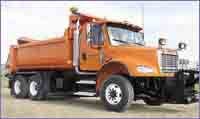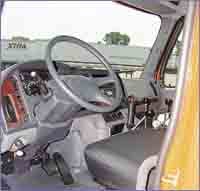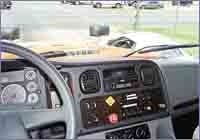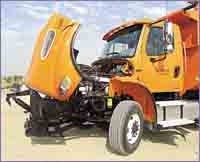M2Vs Mean Business in Snow and on the Go
Snow is a fact of life in places such as Washington County, Minn. Like many municipalities in northern climates, it has a fleet of trucks to push snow aside so people can go about their business. Situated between St. Paul and the Wisconsin border, the county averages 50 inches of snow a year—not in the Snowbelt class, but still something that must be handled when it comes.
Among the county's trucks is the bright-orange 2005 Freightliner M2-112V you see here. It's one of three Business Class units purchased last year, and it means business about snow removal. It has mounts for front, belly and wing plows; plus, of course, the hydraulic apparatus to power them and a beefed-up frame to bear the weight and stresses of operation. The rear of its dump body has a sand/salt spreader, and like the plows, is controlled from inside the snug, warm cab.
"This is the hottest thing in plowing," said Tom Gertgen, a sales representative for J-Craft, the Crysteel Manufacturing division that built the body and mounted the Falls plows and installed the Force America hydraulics. All components were made in Minnesota, by the way. He explained that the belly scraper is mounted further forward on the frame than usual, so it can push its snow into the path of the wing plow, which keeps the snow moving sideways while clearing additional white stuff from the pavement.
With 8 inches of overlap, the 11-foot scraper and 10-foot wing plow can clear about 20 feet of pavement as the truck moves down a street or road. The front plow isn't used until snow is 6 inches deep or more. Of course, like any municipal dump-and-plow truck, this one can perform a variety of hauling and maintenance work in dry weather.
There was no need to operate any of this equipment where I drove the then-spanking-new truck. It was in Dallas, Texas, last September, when Freightliner marketing people showed off two of their Vocational M2s to the construction press. They had borrowed this 112 for the show-and-tell prior to its delivery to Minnesota.
This M2 is a 112-inch-BBC version of the V-for-vocational series first announced last March. Another is the M2-106V, a slightly lighter-duty model with a shorter, 106-inch bumper-to-back-of-cab measurement and a midrange power train. Both went into production in July. The two models are similar in many ways and drove a lot alike. As set up for the intro, the 112's gross weight rating of 58,000 pounds was 3,500 pounds more than the 106's.
Like Freightliner's regular Business Class M2 Series, the vocational models have premium aluminum cabs that engineers consider stout enough as-is, without reinforcement. They also have stouter frames and optional front-frame extensions for mounting of forward PTOs, which can power whatever equipment is needed for specialty applications.
The 106 had a steel flatbed body toting several bundles of plywood and other building supplies. The body was on there temporarily, said Steve Morelli, Freightliner's medium-duty marketing manager, as the truck with its provision for a front-mounted PTO was built for some other duty. He rode along to answer questions and keep me from getting lost.
The two trucks' driving characteristics were similar—quick acceleration, easy turning and great outward visibility. Both had Mercedes-Benz diesels and Allison transmissions: a 350-hp MBE4000 and six-speed RDS4000 in the 112V and a 260-hp MBE900 with a five-speed RDS3000 in the 106V.
The Mercedes engines were gutsy and made throaty mechanical and exhaust sounds that should please anyone serious about truck driving. If you prefer Caterpillar power, the C7 and C9 are optional in the M2-106V, and the C9, C11 and C13 are available in the heavier-duty M2-112V.
The Allisons removed most of the work of driving, leaving me free to concentrate on traffic. I can imagine how much easier the truck and its equipment are to operate because its driver doesn't have to deal with a clutch and gearshift lever. Also, newly hired drivers don't need to learn how to operate a manual transmission, and automatics cushion drivelines against abuse. All that explains why municipalities were among Allison's original customers.
Getting into and out of the cab on either truck was easy with well-placed steps and interior grab handles. The 112V had optional exterior handles for added safety. Inside, the 106V's dashboard had a slanted side panel that places many switches and controls closer to the driver. The 112V had the flat dash where the side panel is a bit further away, but still very reachable. Morelli noted that the flat design was better for the 112V's job because it allows more room for the Addastack console with lever controls for the dump body, sander and plows.
Because the truck was in transit, its plows were not mounted. The front blade was tied down in the dump body, and it provided some modest ballast weight for our drive around the south side of Dallas. We trundled over city streets and expressways, and then over gravel roads and along a dirt levee that in wet weather keeps the Trinity River from washing through the city.
A snowplow truck needs a strong front end, so this one has an 18,000-pound Meritor steer axle mounted on hefty leaf springs. Yet the ride was rather smooth and only occasionally a bit bouncy as we bounded over bumpy and broken pavement. Helping was the compliant TufTrac mechanical suspension on the 40,000-pound tandem rear axles. The truck stopped straight and true from street and freeway speeds.
Probably both trucks' most impressive attribute was their maneuverability. Each turned on the proverbial dime—make that a Sacagawea dollar in today's money—allowing me to properly make 90-degree right turns from curb lane to curb lane. I'd have needed more swing room with the 112V's plows mounted, and a lot more if the wing plow were down. Still, the tight cut of the front wheels has to ease the chore of piloting this rig in a blizzard or afterward, while mopping up roads after a storm.
Introduced three years ago, the second-generation Biz Class trucks also have exceptional outward visibility, and this is true of the vocational variants. Their dashboards are low and hoods slope downward to provide a good view of the road ahead and to the sides. The 112's longer hood was more visible and was accented by the plow mount and lights, but the slope angle still gave a clear forward and front-quarter view. A large peep window in the passenger door let me check for two- and four-wheel traffic directly alongside.
Visibility helped sell the M2V to Washington County authorities, said Mike Swanson, sales manager at the dealer, Interstate Truck Center in Roseville. "They're very safety conscious and the drivers all noticed" the M2V's advantage over higher-hooded competitors already in the fleet when the Freightliner was on display at a truck show, Swanson said.
People in the Northland know that when the snow falls hard and steady, it's good to see any plow come by. But a proudly partisan Swanson said, "it's a nice feeling to look out the window in the morning and see a Freightliner plowing the snow."






